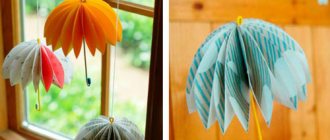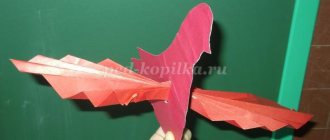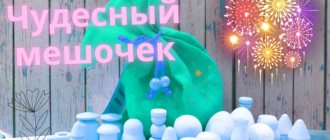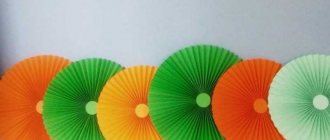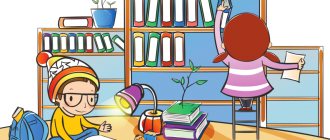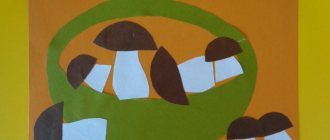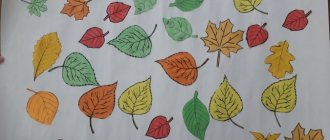SEPTEMBER
1. "SPIDER"
Etc. sod.: teach children to make crafts from various natural materials, to see in them similarities with individual parts. Learn to give the spider expressiveness, create a composition using several spiders and additional objects. Foster a caring attitude towards natural materials.
Materials: thistle flowers, cardboard, awl, wire, acacia seeds, scissors, PVA glue.
Literature: V. Pudova “Toys from natural gifts” p.30
2. “ROOM OF LAUGHTER”
Etc. sod: strengthen children’s ability to fold paper, create a cheerful mood, develop imagination, and the ability to depict different facial expressions using paper.
Materials: thin cardboard or thick album sheet, colored paper, scissors, glue.
Literature: “Working with paper. Crafts and games" page 10
3. "PAPER COUNTRY"
Etc. sod.: teach children to make a variety of toys from the same blank and establish their similarity to familiar objects; learn how to do crafts based on diagrams; develop constructive thinking and intelligence; expand personal and gaming experience; enrich your vocabulary.
Materials: a large sheet of whatman paper, diagrams, squares of colored paper of different sizes and colors for making houses, squares of green paper for making fir trees, scissors, glue, colored paper for decorating houses.
Literature: “Working with paper. Crafts and games" pp. 16-17
4. “BUZZERS”
Etc. sod.: teach children to make musical instruments from various waste materials, design crafts according to their wishes, develop imagination and intelligence, teach them to listen carefully to the work plan.
Materials: yogurt cups, round stick, match, fishing line, rosin, awl, knife. (The teacher does the work with the awl and knife in advance)
Literature: O. Zhakova “Let’s make some noise” pp. 10-11
OCTOBER
1. "BEADS"
Etc. sod.: teach to work carefully with a needle, learn the rules of using a needle, teach children to make crafts from natural materials; develop. Continue teaching preschoolers to clean their workspace. Handle natural materials carefully.
Material: acacia seeds, strong threads, needles, if desired, melon and watermelon seeds.
Literature: V. Pudova “Toys from natural gifts” p.38
2. "TABLECLOTH"
Etc. sod.: teach children to make a variety of toys from the same blank and establish their similarity to familiar objects; learn how to do crafts based on diagrams; continue to learn how to fold paper carefully, iron the folds; develop constructive thinking and intelligence; expand personal and gaming experience; enrich your vocabulary, listen carefully to your teacher and comrades.
Materials: craft diagram, sample, squares of colored paper of different colors, colored paper for decoration, scissors, glue.
Literature: “Working with paper. Crafts and games" page 20
3. “TURNTABLES”
Etc. sod.: teach children to make a variety of toys from the same blank and establish their similarity to familiar objects; learn how to do crafts based on diagrams; develop constructive thinking and intelligence; expand personal and gaming experience; enrich your vocabulary.
Materials: squares of colored paper, pencil for making sticks, cloves, hammer.
Literature: “Working with paper. Crafts and games” page 22.
4. “GIRAFFE. ZEBRA"
Etc. sod.: learn to make crafts from matchboxes, supplement the crafts with details, giving expressiveness and resemblance to real animals. Continue learning to analyze the drawing and sample. Encourage children to make crafts for later use in the game. Develop creativity, imagination, thinking.
Materials: matchboxes, colored paper, samples, diagrams, glue, scissors, simple pencils.
Literature: Tarlovskaya “Teaching preschool children design and manual labor” table 13
Long-term planning for manual labor in the pre-school group
Valentina Kartavaya
Long-term planning for manual labor in the pre-school group
September
1. “Basket” (made of paper and cardboard)
Objectives: To strengthen children’s ability to work according to a pattern (make a square box). Develop the ability to carefully make cuts along the pattern and glue the sides. Foster independence and initiative. Develop a caring attitude towards your comrades.
2. Packaging design. "Groceries Box"
(paper, cardboard)
Objectives: To consolidate the ability to correctly fold a square sheet of paper into 16 small squares, to independently make a pattern for a cubic box.
Develop design abilities, creative thinking, enrich speech.
Foster activity.
October
1. "Mushroom"
Objectives: To increase children's interest in making crafts using the origami technique; Strengthen the ability to follow the teacher’s instructions; Develop fine motor skills of the hands; Cultivate neatness.
2. “Ladybug” (walnut shell)
Objectives: Teach children to make toys according to a model, use plasticine to connect parts of the toy. To form an interest in this type of work, to develop imagination. Follow the rules for working with plasticine and handle the natural material carefully.
November
1. "Swan"
Objectives: Continue to develop in children the desire to engage in manual labor and use skills in working with natural materials. Continue to teach children how to make crafts based on drawings, combine different materials in one craft, and fasten them together using sticks and plasticine. Develop creative imagination, fantasy, cultivate artistic taste, patience, attention, observation.
2. “Vegetables and fruits, healthy products”
(fabric applique)
Tasks: Teach children appliqué from fabric - select color, texture depending on the image being created, outline a stencil with chalk, carefully cut it out, assemble a picture from several parts.
Develop color perception and independence.
December
1. "Snowman"
Objectives: To increase children's interest in making crafts using the origami technique; Strengthen the ability to follow the teacher’s instructions; Develop fine motor skills of the hands; Cultivate neatness.
2. “Fairytale House”.
(made of paper and cardboard)
Objectives: Learn to make a new toy, conveying a fairy-tale image in it (a hut on chicken legs, etc.). Strengthen previously acquired skills in working with paper. Develop children's imagination and creative abilities. Develop the ability to maintain correct posture while working and take care of the health of others.
3. “Three-sided flashlight.”
(made of paper and cardboard)
Objectives: Learn to make a toy using the technique of gluing a pattern. Develop children's imagination. Strengthen the ability to fold paper in a certain sequence and carefully iron the fold lines, carefully cut out decorations for the product. Observe safety precautions when working with scissors.
January
1. "Toy store"
(made of paper and cardboard)
Objectives: Teach children to make toys from paper. Strengthen the ability to fold a rectangular sheet of paper in half, smooth out the fold lines, and cut the blank along the contour. Develop creativity when designing crafts. Follow the rules for working with scissors.
2. “Tablecloth - self-assembled” (weaving from paper)
Objectives: Improve the ability to create form as the basis for a future composition. Improve applique technique: cut with scissors in a straight line, not reaching the edge, intertwine paper strips. Develop dexterity.
Cultivate a love for your home, a desire to make it cozy and beautiful.
February
1. “Machine” (designed
made from matchboxes)
Objectives: To fix in the process of designing from waste material using the method of volumetric modeling the names of vehicles and their purpose; to educate children in safe behavior skills in various road situations and when riding a bicycle.
2. “Rocket” (airplane)
Objectives: To teach children to create an aircraft (spacecraft, using constructive and combined methods from waste material; to arouse interest in designing ships from paper; to form moral and patriotic feelings; to instill in children pride in their country and the achievements of scientists and astronauts; to develop fine motor skills.
March
1. “Beads made from pasta” (bracelet)
Objectives: Educational – to develop the ability to string small and large objects (pasta) onto a thread in alternation; arouse interest in creating a beautiful handmade decoration. Developmental – develop motor skills of the fingertips, a sense of rhythm; develop aesthetic perception.
Educational - to cultivate the desire to create for a loved one - mother, grandmother; cultivate interest in constructive activities.
2. "Tulips"
Objectives: To increase children's interest in making crafts using the origami technique; Strengthen the ability to follow the teacher’s instructions; Develop fine motor skills of the hands; Cultivate neatness.
April
1. “Sun” (from threads)
Objectives: To develop the artistic and aesthetic capabilities of children in creating compositions from woolen threads. Learn how to make a composition from woolen threads.
2. "Wagon"
(from materials used)
Objectives: Teach children to paste over finished boxes with colored paper, after making a pattern. Develop attentiveness, accuracy, and the ability to perform crafts in a certain sequence. Strengthen previously acquired skills in working with paper, careful handling of scissors.
3. “Bookmark”
Objectives: Teach children to make bookmarks for books with their own hands. Develop fine motor skills, eye, interest in your work, imagination, aesthetic taste. Improve your skills and abilities.
May
1. “Fantasies from an accordion”
Objectives: Expand the experience of artistic design of various products based on a generalized method of shaping (accordion)
Develop creative abilities.
Cultivate patience and accuracy.
2. “Frame for family photo”
Objectives: Introduce children to a new way to use cardboard, make a frame for a family photo.
Develop fine motor skills and creative imagination.
Foster love for family and hospitality.
3. "Check"
Objectives: To increase children's interest in making crafts using the origami technique; Strengthen the ability to follow the teacher’s instructions; Develop fine motor skills of the hands; Cultivate neatness.
NOVEMBER
1. “KOKOSHNIKI”
Etc. sod.: teach children to use different natural materials to decorate the kokoshnik, to create a composition. Cultivate a caring attitude towards natural materials and accuracy. Develop imagination, imagination, sense of rhythm.
Materials: kokoshniks made of cardboard and pasted velvet paper, seeds of various plants, dried flowers, leaves, scissors, PVA glue, brushes, sample.
Literature: V. Pudova “Toys from natural gifts” pp. 41-43
2. "CATAMARANS"
Etc. sod.: teach children to make a variety of toys from the same blank and establish their similarity to familiar objects; learn how to do crafts based on diagrams; analyze the diagram; develop constructive thinking and intelligence; expand personal and gaming experience; enrich your vocabulary.
Materials: squares of colored paper, colored paper for decoration, scissors, glue, brushes, diagrams, sample.
Literature: “Working with paper. Crafts and games" page 22
3. “STEAMBOAT WITH TWO PIPES”
Etc. sod.: teach children to make a variety of toys from the same blank and establish their similarity to familiar objects; learn how to do crafts based on diagrams; develop constructive thinking and intelligence; expand personal and gaming experience; enrich your vocabulary.
Materials: squares of colored paper, colored paper for decoration, album sheet or cardboard (1/2 sheet), scissors, glue, diagrams, sample.
Literature: “Working with paper. Crafts and games" page 24
4. “PICTURE FRAME”
Etc. sod.: teach children to fold paper in different directions, making a picture frame. Develop the ability to analyze a drawing. Do the work carefully.
Material: rectangular sheets of white paper (or wallpaper), simple pencil, ruler, drawing.
Literature: Tarlovskaya “Teaching preschoolers design and manual labor” p. 173.
Designing “Trees” from paper (preparatory group).
Author: Andryushchenko Anastasia Nikolaevna
Educational institution: MADO No. 26
Location: Kemerovo, Kemerovo region
Topic: Designing “Trees” from paper (preparatory group).
Library Section: Lesson Developments
Publication date: 03.04.2019
Relevance: The public of the city of Kemerovo is widely discussing the issue of the future fate of the relict forest area Sosnovy Bor. Many citizens express their position through creating petitions, collecting signatures, and publishing on social networks. It is very important to make children aware that every citizen can participate in making decisions that affect the entire city.
Goal: Learning to design various types of paper trees.
Tasks:
To introduce your hometown, its nature, to cultivate patriotic feelings of empathy and inclusion in the life of your city.
Improve skills in working with scissors, accuracy and precision in working with paper,
Continue teaching how to use a dictionary and practice reading
Progress of the lesson
Guys, we have Sosnovy Bor in Kemerovo. Who's been there? And who can answer Is Sosnovy Bor a forest or a park? Sosnovy Bor is located almost in the center of the city and occupies a large area (video) And when is a place for a walk called a park? We can’t answer this question exactly... what do educated people do when they realize that their knowledge is inaccurate? (check in the dictionary).
But who wants to read for themselves and accurately answer what is called a park? (A park is a large garden and a planted grove with alleys, flower beds, etc. A grove is a small, usually deciduous forest.) Can you and I build a park? What will you build in the park? (Gazebo, carousel, etc.) (the teacher places it on the table, draws lines with a pencil) So paths, paths, paths will be trampled... Will there be beauty? what about the amenities? Will not be. It will be both inconvenient and ugly. That’s why architects say: “The park needs to be laid out: alleys should be created (the gesture of drawing an alley), some squares should be designed, with fountains or gazebos...” And what else is needed in the park? (trees) Of course, what kind of park is this? what if there are no trees? We'll line the main alley with fir trees, and the side alley with trimmed linden trees... Or maybe we'll plant groves somewhere... Birch trees would be nice...! And you can make trees (the teacher quickly shows the finished workpiece and makes the desired tree shape from the workpiece). And in a regular park, trees were trimmed in different shapes (cubic, triangular, round...(showing pictures of a regular and landscape park).
Let's stand in a circle, close our eyes and imagine ourselves as trees. (music sounds of the forest sounds). What kind of trees are you, what would you tell park visitors?
I propose to make two workshops. in one we will make trees like this (demonstration). In another one like this (show). First I'll explain how to make each tree. See how to make FIR. I fold the triangle in half. I make slanted cuts like this. Now I unfold the triangle and begin to bend the branches: I press my finger on the fold line at the top and turn the branch out. I press the branch so that the paper remembers the folds. I skip one branch and press on the next fold... and so on until the end. Then I put the finished tree on the table and iron all the folds again.
See how to make a LEAVED TREE. 3-4 rectangles folded together are stapled together like a book. Then we close the book, take it by the fold line and cut out the silhouette of the tree by eye. Like this: stand, trunk, crown. Now we unfold the book and place the tree. I'll clean up my workplace.
Whoever wants to make a spruce will stand on the left, and whoever wants to make a deciduous tree will stand on the right.
What do we need?
The game “There was a birch tree in the field” while the attendants are preparing the group for the lesson. Children take places at the table, prepare everything they need for work. Trees are made. They clean up the workplace and put their own trees in the place of the proposed park.
We have a park. Now guys, let's remember the video. What did Sosnovy Bor look like? Does it look like a park? I suggest you think about it and take part in the discussion along with other Kemerovo residents: Should Sosnovy Bor be left, preserving its pristine nature, or should the green area be improved, making it convenient for visiting: add sculptures, pave paths, etc. It's time for us to go for a walk, we will answer this question when we return to the group.
DECEMBER
1. "CARPET"
Etc. sod.: teach children to make appliqué from natural material on a plasticine basis, develop creativity, imagination, sense of rhythm, learn to compose a composition.
Material: cardboard of various shapes and sizes, plasticine, seeds of various plants.
Literature: V. Pudova “Toys from natural gifts” p.66
2. “COCKER WITH A CHICKEN” (with CSR)
Etc. sod.: teach children to make a variety of toys from the same blank; learn how to do crafts based on diagrams; analyze the diagram; teach children to work in pairs of constant composition, develop patience in children when explaining material, teach them to tell the sequence of doing crafts (one child one way, the other another way), develop speech, develop constructive thinking and intelligence; expand personal and gaming experience; enrich your vocabulary.
Materials: squares of colored paper, colored paper for additional details, scissors, diagrams, glue, samples.
Previous Work: teaching children different ways of making toys.
Literature: “Working with paper. Crafts and games" pp. 30-31
3. “JUMPING”
Etc. sod.: teach children to make a variety of toys from the same blank; learn how to do crafts based on diagrams; analyze the diagram; teach children to work in pairs of constant composition, develop patience in children when explaining material, teach them to tell the sequence of doing crafts (one child one way, the other another way), develop speech, develop constructive thinking and intelligence; expand personal and gaming experience; enrich your vocabulary.
Materials: squares of colored paper, colored paper for additional details, scissors, diagrams, glue, samples.
Previous Work: teaching children different ways of making toys.
Literature: “Working with paper. Crafts and games" pp. 38-39
4. “SNOWFLAKES”
Etc. sod.: teach children to make appliqué from natural material on a plasticine basis, develop creativity, imagination, sense of rhythm, learn to compose a composition.
Material: cardboard of various shapes and sizes, plasticine, seeds of various plants.
Literature: V. Pudova “Toys from natural gifts” p.68
